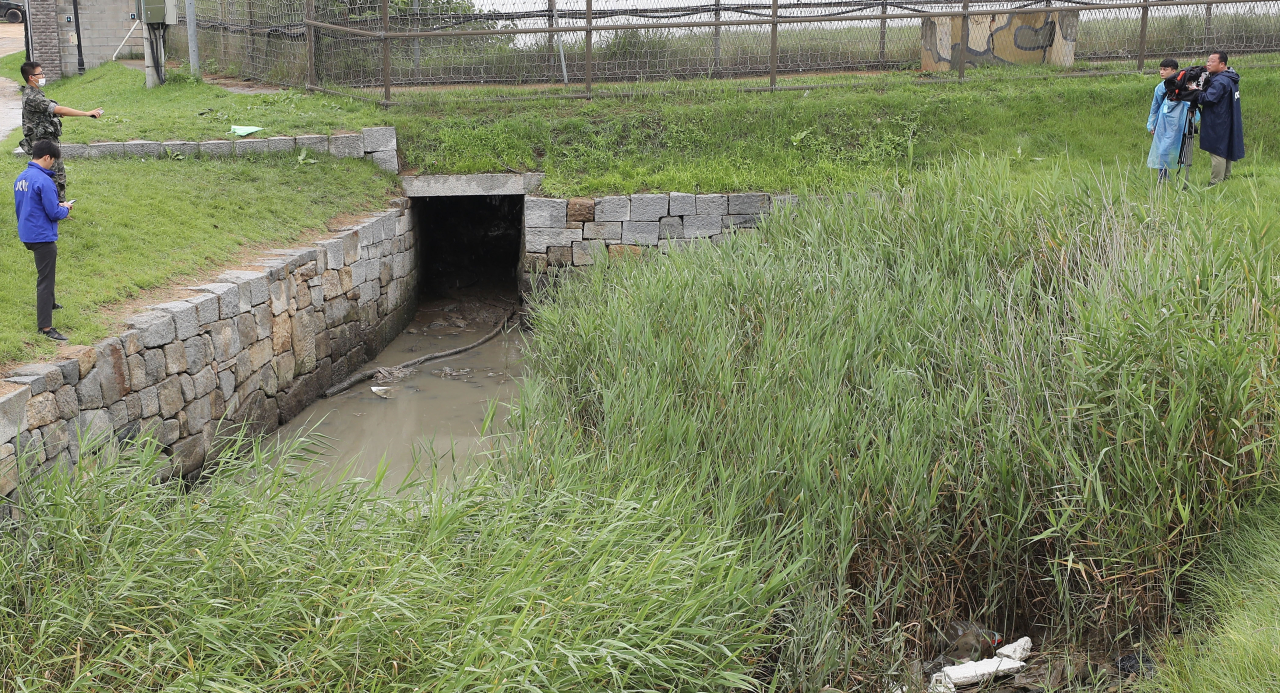 |
The photo taken on Tuesday shows a drain that runs under barbed wire fences in Ganghwa Island, west of Seoul, which may have been used by a North Korean defector to cross the border and return home. (Yonhap) |
Over 30,000 North Korean defectors risked their lives to cross one of the world’s most heavily fortified borders and settle in South Korea, escaping their communist homeland.
Yet not all of them seem satisfied with their new lives in the more prosperous, democratic South. And some even decide to go back to the place they once fled. The latest was a 24-year-old man who swam across the border to return to the North after defecting here three years ago.
The man, identified only by the surname Kim, is believed to have crawled through a drainage ditch under barbed-wire fences and swam to the North on July 19, evading South Korean border guards. His exact reasons are unknown, but he faces a sexual assault investigation here and may have fled back to his hometown, Kaesong, to avoid prosecution.
The Unification Ministry on Monday said 11 North Korean defectors have returned to the North from South Korea since 2015, based on North Korean media reports.
But the figure doesn’t tell the whole story, according to a North Korean expert. When including unofficial figures that are uncounted, the number of “redefectors” could be as high as 100.
“There are estimated to be over 100 defectors (who returned to the North) who are undisclosed, and another 300 accounted for. They may have left for China or another country,” Ahn Chan-il, a defector-turned researcher in Seoul, said during an interview with the CBS radio program “Kim Hyun-jung’s News Show” on Tuesday.
Ahn pointed to difficulties assimilating as the biggest factor behind such stories. “Those in their 20s will go to college, study and make friends, while those in their 40-50s are grateful to see their children study in South Korea. But those in between find it difficult to get married and set their hearts (in Korea),” he said. “(Defectors) are similar to flower pots that were transferred and need to put down their roots.”
“I think they returned because they miss hanging out with their acquaintances back in their hometown in the North,” he said. “Some were unable to adapt to the capitalism, and wish to return to the totalitarian society.”
A vast majority of defectors here have said they struggled to adapt to life in South Korea, due to significant differences in culture, language, education level and lifestyle. While others also expressed difficulties in landing a stable job and making their ends meet in the competitive society.
About one out of five North Korean defectors said they experienced discrimination here last year, due to “cultural” differences, according to a survey conducted by the Hana Foundation, a state-run agency that helps North Korean defectors resettle here.
“Life in Seoul is not easy, but life back in the North is even more difficult,” a North Korean defector who wished to remain anonymous told The Korea Herald. “I hear that when defectors return back to the North, they will be used as propaganda first and then punished later. Because they know what it’s like to live in a free country, the North Korean government won’t let them live with other citizens. When I was back in the North, I saw redefectors in propaganda videos, but they later disappeared.”
Observers also view defector Kim could be used for propaganda in the North against South Korea, just like Lim Ji-hyun in 2017.
Lim, who came to South Korea in 2014, is a female defector who appeared in TV shows here to talk about life in the North. In June, 2017, she resurfaced in North Korea in a propaganda video with a new name Jeon Hye-sung, saying she decided to return after suffering a terrible life here.
By Ahn Sung-mi (
sahn@heraldcorp.com)







![[Today’s K-pop] Blackpink’s Jennie, Lisa invited to Coachella as solo acts](http://res.heraldm.com/phpwas/restmb_idxmake.php?idx=644&simg=/content/image/2024/11/21/20241121050099_0.jpg)
